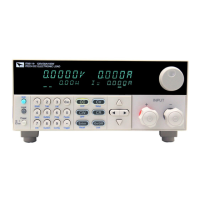Remote Control
Copyright © ITECH Electronic Co., Ltd. 4
The Message Unit
The simplest SCPI command is a single message unit consisting of a command
header (or keyword) followed by a message terminator. The message unit may
include a parameter after the header. The parameter can be numeric or a
string.
VOLTage 20<NL>
Headers
Headers, also referred to as keywords, are instructions recognized by the
electronic load. Headers may be either in the long form or the short form. In the
long form, the header is completely spelled out, such as VOLTAGE, STATUS,
and DELAY. In the short form, the header has only the first three or four letters,
such as VOLT, STAT, and DEL.
Query Indicator
Following a header with a question mark turns it into a query (VOLTage?,
VOLTage:PROTection?). If a query contains a parameter, place the query
indicator at the end of the last header(VOLTage:PROTection?MAX).
Message Unit Separator
When two or more message units are combined into a compound message,
separate the units with a semicolon (STATus:OPERation?;QUEStionable?).
Root Specifier
When it precedes the first header of a message unit, the colon becomes the
root specifier. It tells the command parser that this is the root or the top node of
the command tree.
Message Terminator
A terminator informs SCPI that it has reached the end of a message. Three
permitted message terminators are:
⚫ newline (<NL>),decimal 10 or hexadecimal 0X0A in ASCII.
⚫ end or identify (<END>)
⚫ both of the above (<NL><END>).
In the examples of this guide, there is an assumed message terminator at the
end of each message.
Command execution rules
⚫ Commands execute in the order that they are presented in the program
message.
⚫ An invalid command generates an error and, of course, is not executed.
⚫ Valid commands that precede an invalid command in a multiple command
program message are executed.
⚫ Valid commands that follow an invalid command in a multiple command
program message are ignored.

